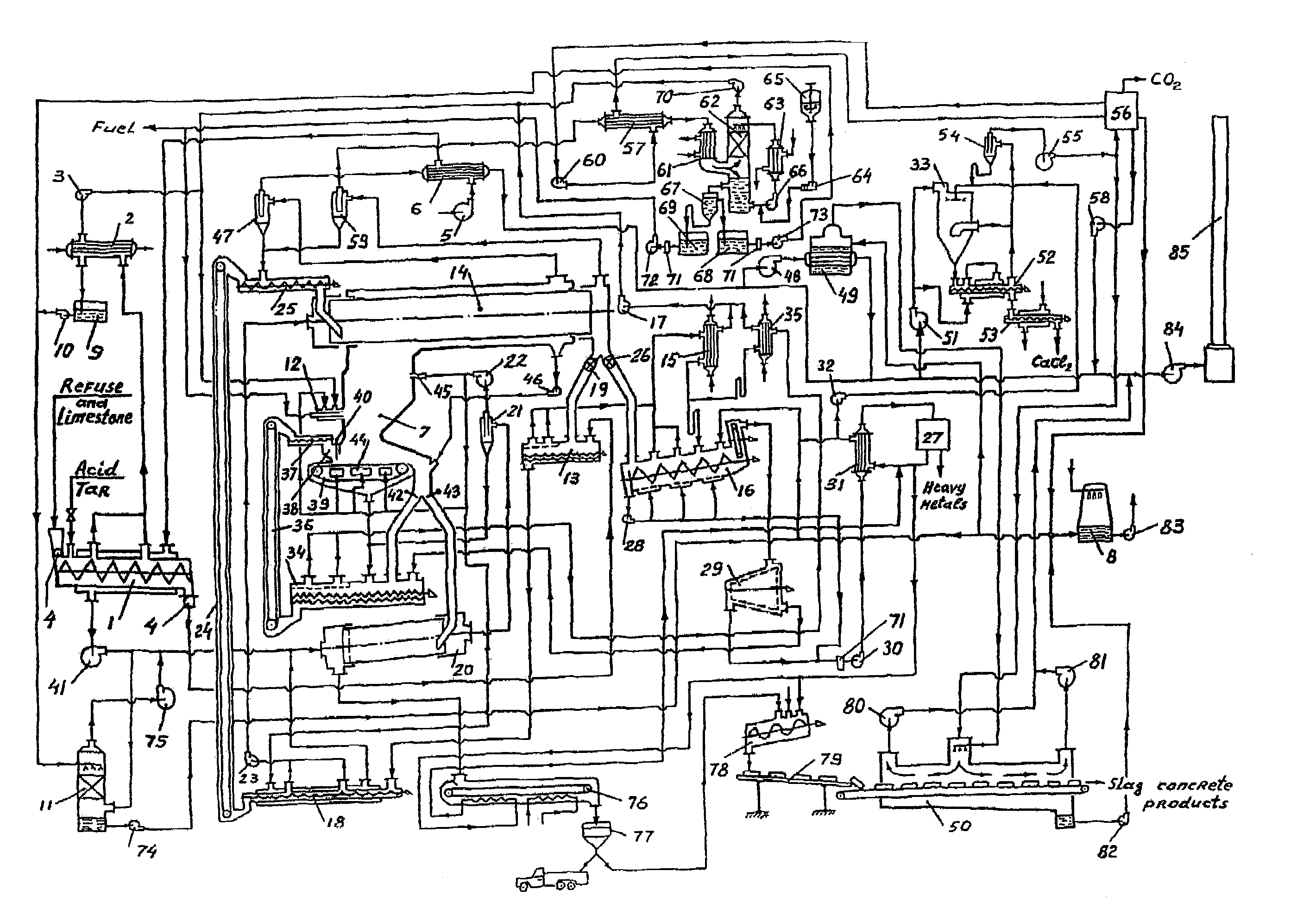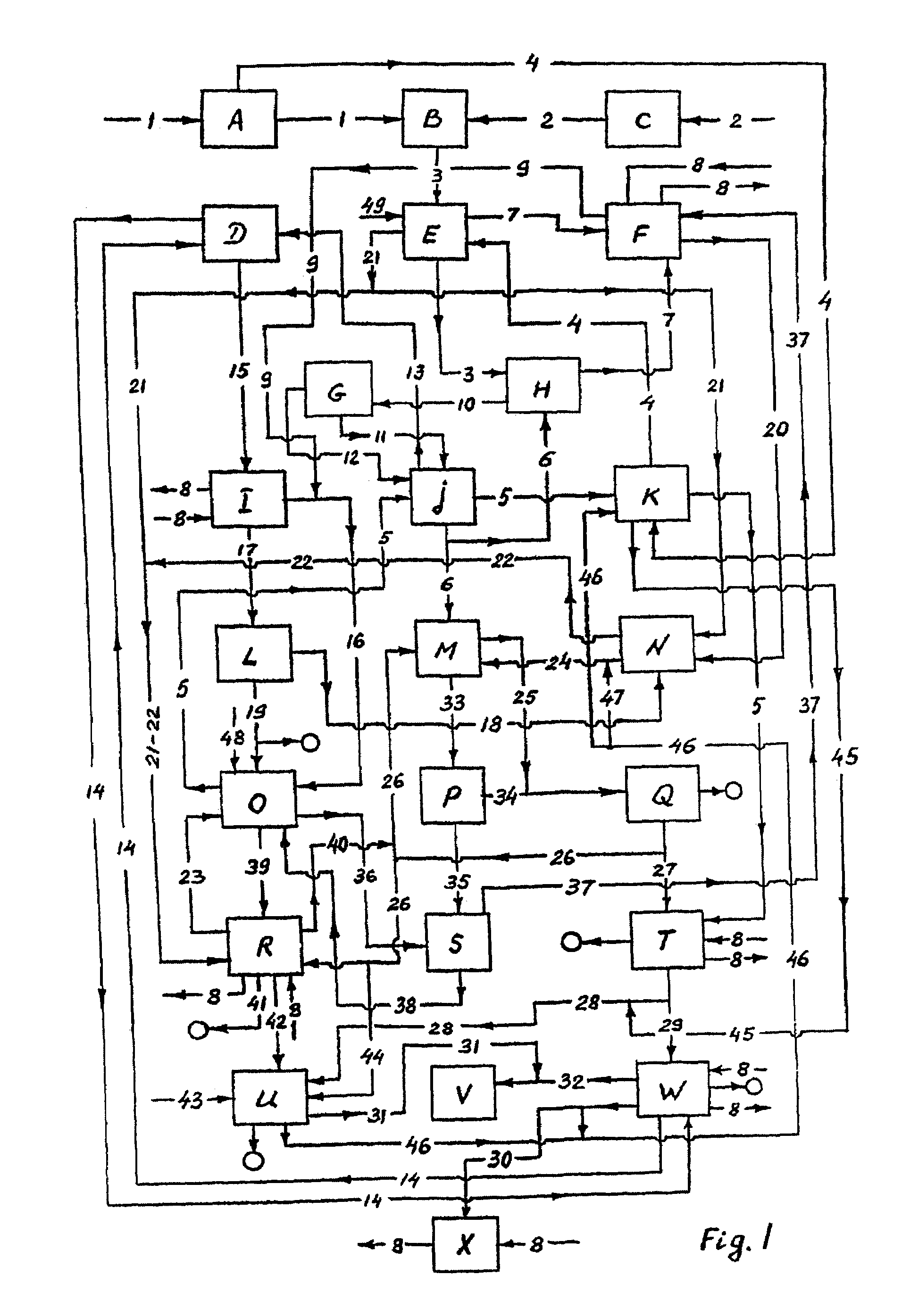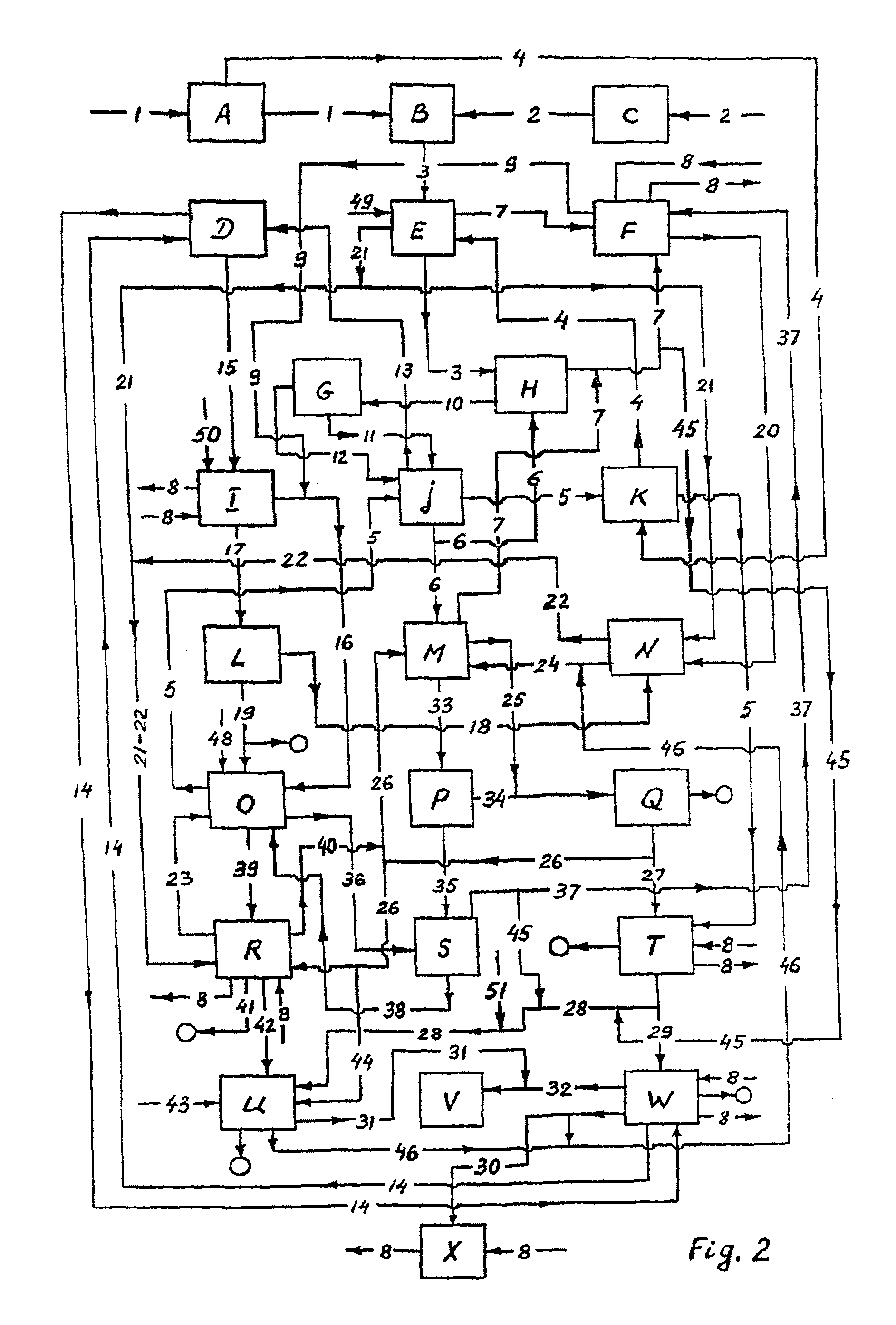The problem of abating
pollution in cities by their own solid municipal wastes is an extremely complex scientific-technical and socio-economic task.
The specific problems include the fact that a large variety of pollutants may comprise the wastes, the fact that the waste products are produced by humans, and the fact that the quantities of these wastes are continuously increasing.
However, such sorting is an extremely laborious, epidemically and toxically dangerous process allowing separation of no more than 30% of the refuse, as it is impossible to successfully separate out the bulk of the refuse.
Experience in Germany has shown, that recycling is economically expedient only for such materials as
ferrous metals, aluminum, glass (depending on local conditions), and probably, paper and is completely unacceptable for plastic, packing materials, newspapers, waste products of
electronics, linoleum, etc.
It is necessary to note that such a solution to the problem is not satisfactory as the solid residues of pyrolysis contain
heavy metals and, hence, are not suitable for industrial use, and so a burial place for the residues is required.
In addition it is impractical to extract oil from ground deposits in view of the high expenses and insignificant quantity of the
oil phase: on the average 5-8%.
However, the questions associated with protecting the environment from
pollution by
heavy metals, polychlorinated dibenzodioxins, -furanes and -biphenyls also would still not be solved.
In connection with the increased content of heavy metals in
sludge deposits of
sewage, all of these technologies result in obtaining extremely dangerous slag and ashes which require a burial place.
Furthermore chlororganic compounds contained in the solid waste result in environmental
contamination by such compounds, in particular, polychlorinated dibenzodioxins, -furanes and -biphenyls.
Furthermore existing plants for refuse
incineration have a lot of drawbacks, the main drawback is that while incinerating the wastes, they form secondary extremely
toxic waste products (polychlorinated dibenzodioxins, -furanes, and -biphenyls) which are exuded together with heavy metals in an environment with
chimney gases,
sewage and slag.
However, burning of solid waste for the purpose of obtaining heat to manufacture
electric power results in even greater environmental
contamination.
Since
electric power consumption is not constant, but has daily and seasonal peaks that accordingly result in fluctuations of the required
waste product load for the combustion chambers of garbage
incineration boilers and, as a result lead to incompletely burning the waste products and to an even greater emission of harmful substances with chimney gases, slag, ash and sewage.
For technical reasons only (low-
calorie fuel, ineffective generators, etc.) the cost of the
electric power generated by using the heat produced in municipal refuse
incineration plants is not competitive with the cost of the electric power generated by using the heat produced in
heat power stations.
Furthermore in view of the laws in force for stabilization of the market price of
electricity to consumers many organizations that generate electric power are obliged to sell
electricity for 2 cents for 1 kilowatt resulting in enormous losses for refuse incineration plants.
In addition the necessity of providing a burial place for slag and ash further renders these plants absolutely unprofitable, and so financial forecasts for their development are extremely adverse (The Wall Street Journal. Aug. 11, 1993, p. A1-A2).
However, the same drawbacks are observed as with the direct burning of waste products.
In order to clear pyrolysis gas of acid gases such as chloride
hydrogen (HCl), it is necessary to employ an expensive b process which becomes expensive because of the need to use expensive equipment and to use expensive caustic or calcinated soda.
Furthermore environmental
contamination by heavy metals is not eliminated.
Such a process does not improve the ecological situation because of the presence of air and the presence of
chlorine-containing organic substances in the refuse, which in combination with high temperature results in intensive formation of chlorinated dioxins, furanes and biphenyls.
In addition salts of heavy metals are not removed in the process and pollute the environment.
The solid residues form without any established industrial process for their further use and resulting in wasted melts of salts and
metal whose regeneration is an extremely complex and power-intensive process requiring in addition a significant consumption of various reagents.
It is necessary to note also that the specified processes do not provide removing of heavy metals and their salts from the solid residue of pyrolysis.
Therefore any further application of slags obtained from those residues for manufacture of building materials and designs is impossible.
Therefore, even though
thermal methods allow considerably reducing the volume of waste products, the resulting ashes that are formed are even more dangerous to the environment and the slag formed requires special measures for recycling or a burial place.
If the waste products are correctly mixed with the cohesive agent “incapsulation” of the toxic substances occurs (including heavy metals and dioxins) in the
cement stone which does not permit passing toxic substances into the environment.
However, such technology requires preliminary
neutralization of waste products employing several chemical reagents.
A number of the substances forming waste products, for example, sulphur-containing substances can cause degradation of the
cement stone that results in
diffusion of contaminants into the environment.
Besides, toxic metals under certain conditions can be washed away from the storage blocks by rains, for example, when there is a change of acidity of rain water according to “weather conditions”.
Commercially such condition cannot be established as the structure of the municipal refuse and accordingly of the slag is not constant.
Thus, even the advanced technologies do not provide manufacture of non-polluting slag, suitable for further use.
Furthermore the cost of a slag burial place is ten times higher than that of a burial place for municipal refuse.
It is the extremely irrational to assume such an ambient temperature because it takes too long and reducing the ambient temperature forms turnaround delays in the release of finished goods.
However, such a way to reduce the
production cycle, and to increase physico-mechanical parameters of products provides significant expenses for construction and operation of boiler-houses, the big charge of the steam reaching 1.2T on 1 m3 concrete and, accordingly, of water and fuel (Dmitrovich A. D. Heat and
Mass Exchange at Hardening of Concrete in the Steam Environment.
All these processes, however, lead to environmental contamination by toxic salts of heavy metals and are not suitable for processing the waste products containing
polyvinyl chloride and other
chlorine-containing plastics in connection with formation of polychlorinated dioxins, furanes and biphenyls.
Furthermore after separation of a condensate of pyrolitic gas into fuel and water phases, additional complex water treating steps are required before the water phase can be dumped into the environment.
However, these methods require careful preliminary sorting of municipal refuse because the methods are unsuitable for burning the waste products containing linoleum, plastic, batteries, accumulators and other materials including chlororganic substances and heavy metals.
The slag and final chimney gases obtained from these waste products contain highly toxic dioxins, furanes,
biphenyl and heavy metals.
In the case where highly damp or frozen waste products are the combustible waste, and also where the combustible waste products are of variable
humidity, the burning becomes chemically unstable, the waste products incompletely burn and, accordingly, the charge of fuel and emission of harmful substances into the
atmosphere as well as into the slag sharply grows.
In Russian Patent No. model—35,257 a unit for pyrolysis of household waste products is described where a chamber of preliminary
drying is designed as a
bunker supplied with ripper and gas burners is powered by gas from the
decomposition of waste products for heating the
bunker up to 150-200° C. However, heating the
bunker with gas obtained from the
decomposition of waste products by an open
flame results in local overheating and, accordingly, premature
decomposition or premature ignition of waste products is possible.
Furthermore obtaining final chimney gases from burners without recycling of heat and which are dumped directly into the
atmosphere additionally pollute the environment and lead to the overexpenditure of fuel.
However, it is impossible, to process the waste products, containing salts of heavy metals and
chlorine organic substances as it is impossible to dump them into the
atmosphere with slags containing polychlorinated dioxins, furanes, biphenyls and salts of heavy metals, and the condensate obtained after cooling of the gas-vapor mixture from a dryer needs complex clearing before dumping into the water drain.
Drying the combustible waste products with final chimney gases reduces the
discharge of fuel, however, direct contact of the environment results in pollution of chimney gases by foul-smelling gases from the combustible
waste product and other harmful substances which then together with chimney gases are dumped in an atmosphere because the
cyclone established before the chimney, entraps only a dust and
soot substances.
And, in addition, high temperatures result in increased volatility of components that lead to an increase in emissions of dangerous heavy metals.
Thus, the method of reduction of concentration of dangerous substances by afterburning has no substantiation and is not capable to reduce emission of products of incomplete combustion and heavy metals.
However, this method is suitable only for processing of industrial residue with a content of dry substances no more than 10% when formed ashes is easily coarsely ground by spheres and then is eliminated on screens.
Such processing of municipal waste products forms a stable fine
grind slag and, accordingly, its separation on screens from the spheres is impossible so that what must often result is a stoppage of the equipment for cleaning.
Use of surplus of gas of pyrolysis is not stipulated as a commodity fuel therefore; it is completely burnt in burners in the
open air,
wasting the energy content, and in addition, its combustion pollutes the environment, so that chemical
neutralization of steam condensate from the dryer is necessary before dumping the condensate down a water drain.
In addition processing waste products containing chlororganic substances and heavy metals, inevitably results in environmental contamination by dioxins, furanes, biphenyls and salts of heavy metals.
However, in
plant removal of
moisture from the heat-carrier or preliminary heating of cold damp refuse is not provided, so that upon their direct contact the temperature of the air can be reduced to its
dew-point temperature which will result in drainage of air due to loss of condensate and, accordingly, to humidifying instead of
drying of refuse.
In the case of an increase of the flow of the hot air which excludes cooling the hot air to its
dew-point temperature, consumption of the electric power for blasting sharply increases which is inherent in the operation of pneumatic dryers.
Besides, to adjust the duration of drying and final
moisture content of dried up refuse is practically impossible.
Therefore non-uniformly dried up waste products enter into a reactor of pyrolysis that, accordingly, result in the overexpenditure of fuel in the pyrolysis process.
Thus, the problem of preliminary drying of municipal and similar waste products before their delivery for thermal processing has no satisfactory solution.
These processes, however, lead to environmental contamination by toxic salts of heavy metals and are not suitable for processing of waste products of plastic, despite that limestone or
dolomite could neutralize the
hydrogen chloride discharged following decomposition of plastic
hydrogen chloride (HCl).
The calcium chloride recovered through such neutralization (CaCl2) under conditions of high temperature in a gasifier 650-980° C. is in a melted condition (the
melting temperature of CaCl2 is 737-747° C. that results in
sintering and lumping of processable waste products, in a sharp decrease of efficiency of contact with the environment so that the process of neutralization of
hydrogen chloride is absolutely not effective and, hence, practically excludes any possibility of processing of plastic.
As the
partial pressure of the vapors of these salts is not enough, they wind up in chimney gases carried away from the furnace in a chimney, and, due to their low concentration it is practically impossible to separate them from the gases though their total proportion in the gases represents a serious
environmental issue.
1. A process for preliminary drying of municipal refuse is not anticipated. It is known that a process of pyrolysis begins only then when water is completely evaporated and the temperature has achieved a critical value where decomposition of organics contained in the refuse takes place. This time period is a function of the
humidity of the refuse at the beginning of the process and can take up to 30-40% of the length of the
residence time of a
waste material in the furnace of pyrolysis. Thus, the presence of
moisture in refuse results in an increase in the
residence time of waste products in the furnace of pyrolysis that essentially reduces its productivity, results in the overcomsumption of fuel and, accordingly, reduction in the out put of commodity fuel.
2. The municipal refuse contains different objects and materials including glass; the temperature interval at the beginning of its
softening depends on the refuse composition, and is equal to 400-600° C. Thus, cooling of slag using air having a temperature below the temperature specified will result in glass-transition and slagging of slag in the cooler and, accordingly, in a stoppage of work in the whole factory.
Slag cooling at a temperature higher than the required temperature wastes a significant part of heat which results in the over-consumption of fuel in the
combustion chamber and, accordingly, in a reduction of the output of fuel which can be marketed.
3. The solid products of pyrolysis after washing out in a
scrubber have
high humidity that require a large consumption of heat from the hot slag used for drying the solid particles in a mixer before feeding to a burning stage. As a result a significant amount of slag is recycled as
ballast to the
combustion chamber which complicates the
burning out of combustible components of the
solid product of pyrolysis, and results in the over-consumption of fuel and, accordingly, reduction of the output of fuel which can be marketed.
4. The manufacture of finished articles from slag is not a practical goal, which considerably reduces
economic parameters of operation of the
plant.
5. With the use of limestone during pyrolysis of municipal refuse to undergo a neutralization reaction with
hydrogen chloride it is impossible to exclude a neutralization reaction with organic acids as well. Therefore to recover organic acids including
acetic acid in significant quantities is impossible. In this connection instead of recovering organic acids it is more rational to carry out the pyrolysis to obtain liquid hydrocarbonic fuel.
6. The water contained within the damp refuse is removed during the process. Due to
evaporation of a plenty of water in dryers of calcium chloride and dump water steams together with final chimney gases into an atmosphere the given technology has no sewage, however, a significant amount of additional
fresh water is needed for cooling of slag by heat exchange with cool water before sending the slag to the
consumer.
7. During neutralization of hydrogen chloride with limestone in the furnace of pyrolysis, calcium chloride is formed which then together with salts of heavy metals is extracting using
wash water. After drying a part of this solution dry calcium chloride is obtained together with a concentrate of salts of heavy metals. Such a mixture is not a marketable product, it is necessary to first separate the calcium chloride from the heavy metals.
8. A complex and expensive preliminary clearing of harmful impurities (acids,
sulfur compounds, etc.) is necessary for producing of liquid
carbonic acid from gases of pyrolysis using chemical sorbents with subsequent clearing of the gas in electrofilters or by compressing the gas under high pressures with subsequent condensation and separation of impurities that renders production of
carbonic acid economically unfavorable and, accordingly, does not reduce emission of
carbon dioxide (CO2) into the atmosphere.
9. The joint burning in
combustion chamber of
liquid fuel, noncondensed gases of pyrolysis and solid products of pyrolysis is executed inefficiently what leads to significant emissions of
nitrogen oxides into the atmosphere.
Such complex design of the furnace creates difficulties while in service including the need for stoppages for cleaning and repair.
 Login to View More
Login to View More 


